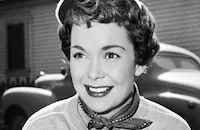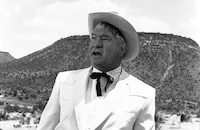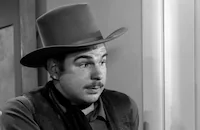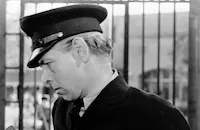The Yearling

Brief Synopsis
Cast & Crew
Clarence Brown
Gregory Peck
Jane Wyman
Claude Jarman Jr.
Chill Wills
Clem Bevans
Film Details
Technical Specs

Synopsis
In the days following the Civil War, pioneer Penny Baxter builds a small house for his wife Orry and their eleven-year-old son Jody in the scrub country of Florida. After clearing and cultivating a patch of fertile ground, Penny names his new home "Baxter's Island" and begins the hard work that will be needed to provide food for his family. When Jody is not busy helping his father with the chores, he wanders through the backwoods and marvels at the wide array of wildlife. Jody develops a great appreciation for animals, but when he asks his parents for permission to adopt a baby raccoon as a pet, his mother sternly forbids it. Penny later explains to his son that Orry is opposed to bringing in a pet because she is still grieving the premature deaths of three of their children. One day, when a wild bear, nicknamed "Old Slewfoot," kills the family calf, Penny and Jody set out to kill the bear. During the hunt, the bear attacks one of Penny's favorite hounds and escapes into the wilderness.
The next day, Penny and Jody visit their neighbor, Pa Forrester, whose sons are prone to fighting and cheating. While Jody plays with his young crippled friend, Fodderwing, Penny trades his hound for a better rifle. A short time later, Penny discovers that his hogs have been stolen and immediately suspects the Forrester boys. En route to the Forresters, with Jody at his side, Penny is bitten by a rattlesnake. To save his father's life, Jody is told that he must shoot a doe and use its heart and liver to treat the snakebite. Jody follows his father's instructions, and then races to the Forresters to get help for Penny. Millwheel is the only member of the Forrester family who agrees to help Jody, and a doctor arrives in time to save Penny's life. After he recovers, Penny shows his gratitude for his son's heroic actions by allowing him to adopt the fawn of the doe that was killed. Jody is happy to finally have the pet he always wanted, and the fawn, which he has named "Flag," becomes his constant companion.
A series of tragedies later befalls the Baxters, beginning with the sudden death of Fodderwing and followed by the loss of an entire crop to bad weather. As Jody tries to understand his friend's death, Penny does his best to comfort him and delivers a moving eulogy at the funeral. The Baxters attempt to save their farm by planting tobacco to replace their lost crop, but Flag later ruins the crop. When Flag becomes a yearling, Penny considers turning him loose but Jody adamantly refuses.
One day, Penny injures himself while working in the field and becomes bedridden for a lengthy period of time. Jody takes over the duties of running the farm, and learns how to hunt for dinner. When Flag destroys the family corn crop, Orry vows to get rid of the deer. Again, Jody pleads with his father to spare Flag, but because the deer has destroyed the last of their food, Penny insists that the deer must go. Jody ignores his father's orders to shoot Flag, and instead tearfully sets Flag loose in the woods. Flag follows Jody home, though, and when Orry sees the deer, she shoots it. The shot does not kill Flag, so Jody is forced to relieve the deer of its pain with a final shot. The incident proves too much for Jody to bear, and he runs away from home. After drifting down a river on a rowboat for days, Jody is found nearly starved by a steamer crew and sent home. Orry, who has been searching for Jody, makes amends with her son, while Penny reaffirms his love for him.

Director

Clarence Brown
Cast

Gregory Peck

Jane Wyman

Claude Jarman Jr.

Chill Wills

Clem Bevans

Margaret Wycherly

Henry Travers

Forrest Tucker
Donn Gift

Daniel White

Matt Willis

George Mann

Arthur Hohl
June Lockhart
Joan Wells
Jeff York
B. M. Chick York
Houseley Stevenson
Jane Green
Victor Killian
Robert Porterfield
Frank Eldredge
Crew
Arthur Arling
Joe Boyle
Clarence Brown
Jack Dawn
Frederick Delius
Victor Fleming
Chester M. Franklin
Sidney Franklin
Cedric Gibbons
Paul Groesse
Irene
Henri Jaffa
Natalie Kalmus
Harold F. Kress
Mel Long
Jay Marchant
Warren Newcombe
Paul Osborn
Al Raboch
Charles Rosher
Hal Rosson
Richard Rosson
Albert Sendrey
Douglas Shearer
Leonard Smith
Ralph Steiner
Herbert Stothart
Herbert Stothart
Valles
Paul Vogel
Edwin B. Willis

Photo Collections
Videos
Movie Clip


Trailer
Hosted Intro



Film Details
Technical Specs

Award Wins
Best Art Direction
Best Cinematography
Academy Juvenile Award
Award Nominations
Best Actor
Best Actress
Best Director
Best Editing
Best Picture
Articles
The Yearling - The Yearling
Shooting began in 1941, with Victor Fleming as director. After only three weeks, the cast and crew returned to Hollywood. Rumors abounded of differences in temperament among the people working on the film, and MGM then announced that King Vidor would replace Fleming as director. The studio soon realized that the film wasn't going to work if they continued as planned. The animals that had been trained for the film were growing too quickly, so new animals would have to be trained. Eckman's Southern accent didn't mesh well with Tracy's manner of speaking and he was hard to understand. Soon, the project was shelved, but in 1944 it was brought back into the forefront of the studio's productions. (The film had sat on the backburner for a few years because Hollywood's war films were so popular that the producers didn't think a film about animals would fare well.)
When production resumed, Gregory Peck and Jane Wyman had been cast as Ma and Pa Baxter. Shooting began once again in Florida with Clarence Brown as director, and it soon became apparent that Eckman had grown too old for his role as Jody. Another talent search was launched, and Brown discovered Claude Jarman, Jr. in his Nashville, Tennessee elementary school. The unpredictable and sometimes harsh climate of Florida plagued the shoot for its duration, but filming finally wrapped in February of 1946. The film was released in Los Angeles at the end of that same year so it could qualify for that year's Academy Awards. It turned out to be well worth all the problems everyone had endured over the past few years; the film received a total of six Oscar nominations. Peck and Wyman were nominated for Best Actor and Best Actress, and Claude Jarman, Jr. was given an honorary Oscar for "outstanding child actor of 1946". Oscars were won for art direction and set decoration, and for Technicolor photography.
In addition to being a critical success, The Yearling was a huge commercial success, grossing over $5.2 million nationally. People of all ages can appreciate this coming-of-age film about a boy who learns to deal with love and loss, through a special friendship with a pet deer.
Director: Clarence Brown
Producer: Sidney Franklin
Screenwriting: Paul Osborn
Cinematography: Charles Rosher, Leonard Smith, Arthur E. Arling
Editor: Harold F. Kress
Art Direction: Cedric Gibbons, Paul Groesse
Music: Herbert Stothart
Cast: Gregory Peck (Pa Baxter), Jane Wyman (Ma Baxter), Claude Jarman, Jr. (Jody Baxter), Chill Wills (Buck Forrester), Clem Bevans (Pa Forrester), Margaret Wycherly (Ma Forrester).
C-129m. Closed captioning. Descriptive Video.
by Sarah Heiman

The Yearling - The Yearling
Quotes
Trivia
Notes
Unless otherwise noted, the following information about the film was taken from contemporary news items in Hollywood Reporter and New York Times and Hollywood Reporter production charts: The Yearling, based on Marjorie Kinnan Rawlings' Pulitzer Prize-winning novel, had a long and troubled production history. According to information contained in AMPAS Library file on the film, in 1938, shortly after M-G-M purchased the rights to the novel, the studio engaged Rawlings to help M-G-M photographers to select locations in the Ocala National Forest, in Florida, that were appropriate for the setting of her story. With the expectation that shooting on the Sidney Franklin production would begin in mid-1940, M-G-M leased a farm in Florida and planted crops there. The start date of the film was postponed, however, due to M-G-M's inablility to cast the role of "Jody Baxter." Filming began a year later under the direction of Victor Fleming, with the top roles being played by Spencer Tracy (as "Penny Baxter"), Gene Eckman (as "Jody Baxter"), Ann Revere (as "Ma Baxter"), Adeline deWalt Reynolds (as "Ma Forrester"), Tully Marshall (as "Pa Forrester") and Chill Wills. Actors Barton MacLane and Cecil Kellaway were considered for roles in 1941. Hal Rosson was the cameraman in 1941 and worked with a company numbering approximately 300.
Due to several production difficulties, the film was shelved two months after it had begun, after an expediture of half of its $1,000,000 budget. M-G-M offered no official explanation for halting the project, except to note that it was done "in the best interests of the company." While it was rumored in some contemporary news items that the film was shelved because Eckman was found to be unsuitable for his role, others reported that the production was halted because the fawns the studio had been raising for the film were growing too fast. In addition, several disputes between Tracy and Fleming were reported, as were problems posed by the weather, uncooperative animals and sand.
Fleming withdrew from the film in June 1941, and King Vidor was brought in to replace him. Vidor reportedly told M-G-M that he could not salvage the production on such short notice, and the film was shelved again shortly thereafter. In February 1942, M-G-M announced that Roddy McDowall had been tested for a role, and that filming would resume, although this time the picture was to be shot entirely at the M-G-M studios. Tracy again was set to star, and Sidney Franklin was named as a possible director. Cameraman Paul Vogel filmed screen tests for the film in March 1942, but the Franklin-directed production never materialized.
No further production activity on The Yearling was reported until November 1944, when a Hollywood Reporter news item announced a spring 1945 start for the film. Clarence Brown was assigned to direct the film, and Leonard Smith was the new cameraman. News items also announced that much of the original footage filmed in the Ocala National Forest would be salvaged, and that the production would return there for additional filming. Tracy was replaced by Gregory Peck, and it was announced that Eckman, who had outgrown his part as "Jody," would also be replaced. Tommy Lee was tested for the role of Jody in January 1945, but the part eventually went to Claude Jarman, Jr., who made his motion picture debut in the film. According to M-G-M publicity materials, Jarman was personally selected for the part by Brown and production manager Jay Marchant after an eight-state search through the South for an unknown young actor. Brown and Marchant discovered the eleven-year-old Jarman on February 14, 1945, at a grammar school in Nashville, Tennessee, and persuaded his family to move to Hollywood.
While M-G-M waited for Peck to complete his work in the film Duel in the Sun, Brown began filming some location sequences in Ocala and Silver Springs, Florida. In all, about three dozen locations in Marion County, Florida, were used. Filming of the dramatic scenes resumed in the summer of 1945 with actress Jacqueline White playing "Ma Baxter." According to a studio publicity item, White was being groomed for stardom by M-G-M, and her appearance in The Yearling was to be her first major part in a film. White enacted her role through late August 1945, when shooting was halted again, this time for nearly a month. Production resumed in mid-September with Jane Wyman replacing White, and with James Craig, Henry Travers and June Lockhart added to the cast. Chill Wills, who had been cast as "Buck" in 1941, returned in the same role. Craig was later replaced by Jeff York.
A November 1946 article in Liberty magazine, entitled "Them Hollywood Nuts," gives a detailed account of the numerous production difficulties that plagued the Florida location filming between 1941 and 1945. The troubles included swarming insects, injuries suffered from animal attacks, a hurricane that destroyed Brown's set, and Jarman's bout with the measles. The following individuals were mentioned in the Liberty article as having worked on the production in the summer of 1945, although their contribution to the final film has not been confirmed: Eddie Faust, animal trainer; Mac Weatherwax, dog trainer; Charles O'Malley, supply officer; Rose Allen, snakebite double for Peck; Lee Stanfield, makeup; and Lew Crolley, props. An undated M-G-M publicity item in the AMPAS Library production file of the film noted that Wyman and Peck were to be joined by silent film star King Baggot, making his "comeback" in the role of "Pa Weatherby," but Baggot did not appear in the film. Wyman was borrowed from Warner Bros. for the production.
In October 1945, after completing some location shooting at Lake Arrowhead, California, the production moved to the M-G-M lot in Culver City for additional filming. M-G-M built a replica of the Baxter farm on its backlot, and much of the Baxter farm set, which covered 7,500 square feet, was reconstructed from parts of the Florida farm that were shipped to California. A second unit returned to Silver Springs in early November 1945, about the time that Hollywood Reporter production charts began listing Charles Rosher as the cameraman. According to publicity materials, a total of 312,564 feet of film were exposed in making the picture. The production required six separate expeditions between Culver City and Florida, a cast and crew of 410, along with some 2,644 additional workers who were not studio employees. Publicity materials also note that 81,023 pounds of Spanish moss from Florida was shipped to the M-G-M studios in Culver City, where some of the outdoor settings were duplicated.
The December 18, 1946 world premiere of The Yearling, which took place at the Carthay Circle Theatre in Los Angeles, was held as a charity event sponsored by the Assistance League of Southern California, with proceeds donated to United States Navy Library in Guam. The film opened to the public in Los Angeles on December 25, 1946, in New York one month later, and had roadshow engagements at select theaters until its general release in the May 1947.
A November 1946 Hollywood Reporter news item noted that Brown asked permission from M-G-M to finance and direct a stage version of The Yearling, but no further information about the outcome of Brown's proposed stage version has been found. The film opened to generally favorable reviews, with Variety calling the picture "one of the better contributions to the screen." The New York Times reviewer lavishly praised the performances of Jarman and Peck, and called the film "cheerful and inspiring." The Yearling won Academy Awards for Best Color Cinematography and Best Art Direction/Interior Direction (Color), and Claude Jarman, Jr. received a special Academy Award for "Outstanding Child Actor of 1946." The film was also nominated for Academy Awards in the following categories: Best Picture, Best Actor (Peck), Best Actress (Wyman), Best Direction and Best Film Editing. This was the last film photographed by longtime M-G-M cameraman Leonard Smith, who died of a heart attack in October 1947, at the age of 53. Peck, Wyman and Jarman recreated their roles for a Lux Radio Theatre adaptation of The Yearling on January 19, 1948. A made-for-television adaptation of the story aired on the CBS network on April 24, 1994, starring Peter Strauss, Jean Smart and Will Horneff.















